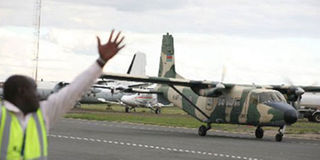Aircraft service firm opens Kenyan branch

Wilson Airport where a Canadian aircraft training institution has opened its first branch in Kenya. This could reduce the cost of airline maintenance courses. Flightline Training Services, based in Toronto, recently opened its classes at Wilson Airport in Nairobi where airline engineering trainees will be able to acquire knowledge on more than 20 aircraft types. PHOTO/FILE
What you need to know:
- It is estimated that it costs Sh2 million a year to train an aeronautical engineer in America and the United Kingdom.
- Presently, the firm offers technical training on the CRJs, Dash 8, ATR, DHC-6, Twin Otter, King Air, Boeing-777, and EMB among other types like Cessnas.
- To minimise costs, the institution relies on graphic and simulation teams which enable it to provide customised courses that respond to specific needs while maintaining high standards.
A Canadian aircraft training institution has opened a branch in Kenya. This could reduce the cost of airline maintenance courses.
Flightline Training Services, based in Toronto, recently opened its classes at Wilson Airport in Nairobi where airline engineering trainees will be able to acquire knowledge on more than 20 aircraft types.
Chief executive Phyl Durdey said human resource in the aviation industry, especially in emerging economies like Kenya, is still a challenge due to the high cost of training staff abroad.
“This facility is not for Kenya alone but is expected to serve the larger Eastern Africa region,” said Mr Durdey. Founded in 2001, Flightline has established a worldwide presence, operating in 21 countries across the world.
It is estimated that it costs Sh2 million a year to train an aeronautical engineer in America and the United Kingdom.
REDUCED COSTS
Mr Durdey said Flightline intends to cut this cost to almost the Sh250,000 charged in China, where most Kenyans are said to be seeking training alongside Ethiopia and South Africa.
Presently, the firm offers technical training on the CRJs, Dash 8, ATR, DHC-6, Twin Otter, King Air, Boeing-777, and EMB among other types like Cessnas.
To minimise costs, the institution relies on graphic and simulation teams which enable it to provide customised courses that respond to specific needs while maintaining high standards.
Statistics indicate that Africa faces a shortage of aviation professionals, with demand outstripping supply for skills needed to keep commercial fleets flying safely.
The shortage is greatest for aeronautical engineers, flight dispatchers, air cargo, dangerous goods personnel, and aircraft information officers.
Lack of adequate engineers has thus been identified as a major setback in the development of the Kenyan aviation industry even as the country witnesses growth in the sector.
Kenya still relies on foreign engineers, with high cost of training being cited as a deterrent to the development of the skill. The allure for high pay also results in brain drain.
In Kenya, aircraft landings and take-offs increased from 195,000 in 2008 to 335,000 in 2011. The number of planes registered rose from 757 to 1,056.
The country has witnessed growth in the aviation industry with an influx of foreign airlines while existing ones continue to increase their fleets while opening up new routes as passenger and freight volumes rise.
According to statistics from the Aeronautical Society of Kenya, the country has a deficit of about 800 aviation professionals due to lack of capacity to train competent staff as fast as the industry is growing.




